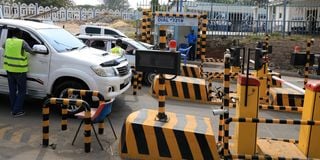Cashless payment system saves Likoni ferry money

Motorists at the Likoni Ferry Crossing in Mombasa use a cashless payment system. Once payment is done, the new system captures the vehicle’s number plate, and once approved, the barrier gate will automatically open to let the driver through.
When the Kenya Ports Authority (KPA) introduced a cashless payment system at the ferry on the Likoni channel in Mombasa City three years ago, little did its officials know that they were losing close to Sh1 million in revenue daily due to corruption.
KPA installed smart barrier gates that only allows a motorist to pass through after they have made an electronic payment in 2020 as a measure to increase revenue and curb fraud on the busy channel, where more than 6,000 vehicles and 300,000 pedestrians cross daily.
According to data from the operations department, at least Sh2.5 million is now collected every day from vehicles crossing the channel.
This is an increase from the Sh1.8 million that was collected previously.
Once a payment is made either by mobile money, debit or credit card, the system captures the vehicle's number plate and once approved, the barrier gate will automatically open to let the driver pass through.
Motorists use a USSD code to conduct transactions on the phone.
KPA Ferry Operations Communication Officer Elizabeth Wachira said this has enhanced the efficiency of the ferry and increased revenue collection
It has also helped curb traffic snarl-ups that came as a result of payment delays.
"Previously, some of the workers would collude with motorists allowing them to cross without paying the charges," Ms Wachira told Nation.
With the new payment system, she said, money is collected and banked on the spot.
"'We used to have system failures where it would take long before a motorist got a confirmation message. It was also limited to only one mobile service provider. But now, the money is banked directly," she explained.
Other than failure to pay, Ms Wachira said some of the motorists would lie about the size of the vehicle and end up paying way less than the required amount.
The charges for vehicles range between Sh120 for small cars to Sh7,900 for a loaded oil tanker.
Nation has established that it is now impossible for a vehicle to go through the barriers without payment.
For instance, the four barrier gates that have been placed on both sides of the channel, are fitted with sirens that go off in case a vehicle tries to forcefully go through.
Mr Rajab Kombo, who leads the project, told Nation: “The project is still at the pilot stage. It will take a few more months before it becomes fully operational.”
KPA’s takeover of ferry services is a return to the system that was used before the formation of Kenya Ferry Services (KFS).Before KFS was established, ferry service used to be under KPA.
The agency took over from the Kenya Bus Services, which ran ferry operations until 1989 when it decided to pull out.The ferry connects Mombasa City to Kwale County and Tanzania via the Lunga Lunga border.
But pressure on the channel is set to reduce upon completion of the Dongo Kundu bypass that comprises a bridge connecting Mombasa to Kwale.





